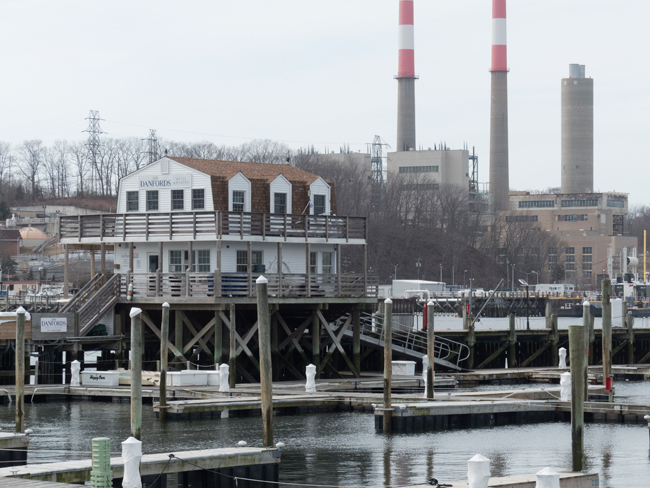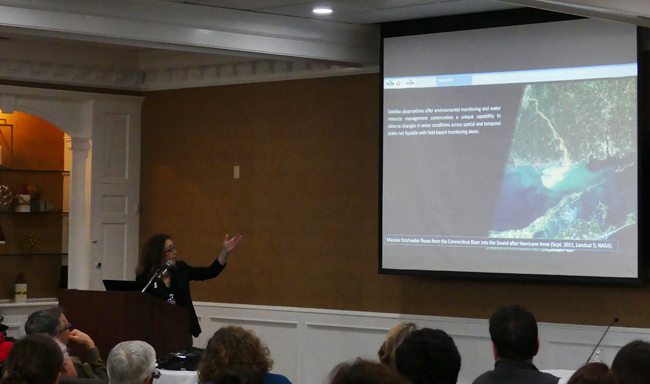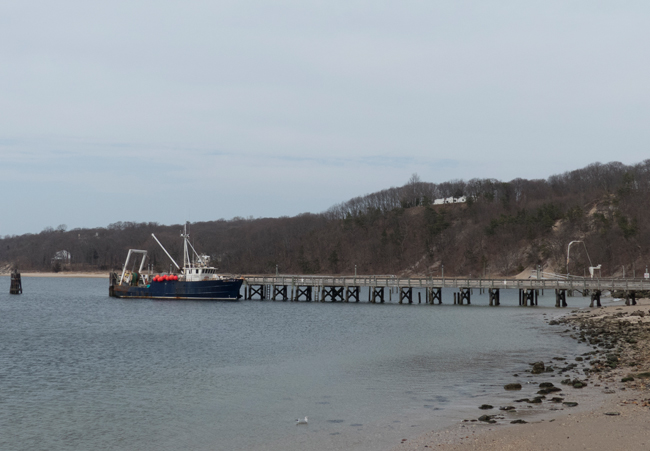
The 2019 Long Island Sound Research Conference, hosted by New York Sea Grant, was held on Friday, March 15th at Danfords Hotel and Marina in Port Jefferson, New York. Credit: Ryan Strother / NYSG.
Contacts:
Lane Smith, NYSG Research Program Coordinator, E: Lane.Smith@stonybrook.edu, P: (631) 632-9780
Port Jefferson, NY, April 16, 2019 - New York Sea Grant (NYSG) hosted the 2019 Long Island Sound Research Conference at Danfords Hotel and Marina in Port Jefferson, New York. The conference—co-sponsored by the Long Island Sound Study (LISS), Connecticut Sea Grant and NYSG—served as an opportunity for marine researchers to cross their usual boundaries of interests and learn about science happening in a wide array of subjects and disciplines. Over 100 Long Island Sound (LIS) scientists, researchers, managers and educators from Long Island and mainland shores gathered to discuss research and possible solutions to some observed problems.
The day was divided into concurrent sessions, covering Nutrients/Chemistry, Microbes/Water Quality, Management/Sustainability, Physical/Geological Processes and an Around the Sound session featuring research across disciplines. A complete abstract and agenda for the event can be found here (pdf); the following is merely a glimpse of all the studies happening around the LIS and its watershed. In total, 27 presentations and 22 posters detailing research from individuals and institutions all over the Sound were exhibited.

Maria Tzortziou of the City College of New York presents her research titled “Satellite Ocean Color Observations from NASA's PACE Mission: Addressing Environmental Challenges and Enhancing Environmental Management Decisions.” Credit: Ryan Strother / NYSG.
During one study featured in the Microbes/Water Quality session, moderated by former NYSG Director Jim Ammerman, researchers from Yale University and the East Shore District Health Department presented their respective projects related to the water quality and microbial presence in Long Island Sound. During the Management/Sustainability session moderated by NYSG Interim Director Katherine Bunting-Howarth, Sacred Heart University researcher Mary Dushay explored the role that living shorelines play in providing accessible habitat for wildlife conversion on shoreline. Dushay noted the challenge creatures like horseshoe crabs can have completing their lifecycle on shore when impeded by bulkheads or rip rock.
During the Fisheries session, Sabrina Geraci-Yee, Jake Collier and Bassem Allam presented their work on the ecology of the hard clam pathogen, “Quahog Parasite Unknown” or, QPX disease in a study funded by New York Sea Grant. A critical issue in the management of QPX is the question of whether or not QPX is an obligate or opportunistic pathogen. The Stony Brook University researchers’ study supported that QPX is an opportunistic pathogen, highlighting the need for improving current management approaches.
Research impacting a sound environment on the West Coast was also included. Dr. Parker MacCready was invited to present his work, “Realistic Ocean Modeling for Applied Science Problems in the Pacific Northwest” during the midday plenary session. Early in his career MacCready, a current faculty member at the University of Washington, had students compare data with Long Island Sound and Puget Sound during a course early in his teaching career. MacCready discussed the application of several ocean models and data sets for creating short-term condition models in Puget Sound. By integrating National Oceanic and Atmospheric Administration (NOAA) integrated ocean models, UCSC, OSU and other overlapping models, the LiveOcean model can be applied to solve problems such as the source of invasive European green crabs entering Puget Sound and short term forecasts of phytoplankton blooms. Long Island Sound researchers were afforded the opportunity to engage with ocean modeling in the Puget Sound through their perspective lens of the LIS.
A panel discussion then dove into sediment-water column connections and the impact of sediments on LIS water quality. Wally Folweiler of Boston University, Craig Tobais and Penny Vlahos of the University of Connecticut and Kamazima Lwiza of Stony Brook University facilitated a technical discussion about the complexities of LIS sediment biogeochemistry.
The day concluded with poster lightning talks, moderated by Lane Smith, NYSG’s Research Program Coordinator and organizer of the research conference. Researchers gave short synopsis of their research, which were later displayed and discussed during the poster session.

Docked just across from Danfords, the once NOAA Research Vessel Bagatell is currently owned by Stony Brook University's School of Marine and Atmospheric Sciences, which has converted it into the R/V Seawolf. Take a virtual tour via SoMAS' Web site.
Though the LIS Research Conference is complete, an abundance of scientific research continues into 2019 and beyond. For example, four studies funded as part of the LISS Research Grant Program were introduced at the conference. One such study is the “LIS Respire Program,” which allows investigators Vlahos, Jamie Vaudrey and Michael Whitney to gain a better understanding of how oxygen is being used in the water column of Long Island Sound. Results of the study will help inform decisions that seek to avoid hypoxia and manage the estuary sustainability amidst coastal population growth and a shifting climate. For more on those projects, see "Over $1.5 Million Funds Four Long Island Sound Research Projects."
More Info: Long Island Sound Research Conference - A History
This conference began as a response to a recommendation by the Long Island Sound Assembly that there should be a venue where all of the current science relating to Long Island Sound could be presented. The first Long Island Sound Research Conference occurred in 1992. Historically, the conference was organized by the Long Island Sound Foundation until 2016, when Sue McNamara retired.
The idea was to gather scientists and students from all of the relevant disciplines together, to present and synthesize a big picture of Long Island Sound science. Financial support came via the Sea Grant programs of Connecticut and New York. Proceedings volumes were produced, and are still available from Sea Grant, on loan from the National Sea Grant Library or in digital form at the Foundation’s website. Organization of the conference is now shared by the Sea Grant programs of Connecticut and New York.
Support for the Long Island Sound Research Conference is provided by the Long Island Sound Study.

More Info: New York Sea Grant
New York Sea Grant (NYSG), a cooperative program of Cornell University
and the State University of New York (SUNY), is one of 33 university-based
programs under the National Oceanic and Atmospheric Administration’s
National Sea Grant College Program.
Since 1971, NYSG has represented a statewide network of integrated
research, education and extension services promoting coastal community
economic vitality, environmental sustainability and citizen awareness
and understanding about the State’s marine and Great Lakes resources.
Through NYSG’s efforts, the combined talents of university scientists
and extension specialists help develop and transfer science-based
information to many coastal user groups—businesses and industries,
federal, state and local government decision-makers and agency managers,
educators, the media and the interested public.
The program maintains Great Lakes offices at Cornell University, SUNY
Buffalo, SUNY Oswego and the Wayne County Cooperative Extension office
in Newark. In the State's marine waters, NYSG has offices at Stony Brook
University in Long Island, Brooklyn College and Cornell Cooperative
Extension in NYC and Kingston in the Hudson Valley.
For updates on Sea Grant activities: www.nyseagrant.org has RSS, Facebook, Twitter, and YouTube links. NYSG offers a free e-list sign up via www.nyseagrant.org/nycoastlines for its flagship publication, NY Coastlines/Currents, which is published quarterly. Our program also produces an occasional e-newsletter,"NOAA Sea Grant's Social Media Review," via its blog, www.nyseagrant.org/blog.